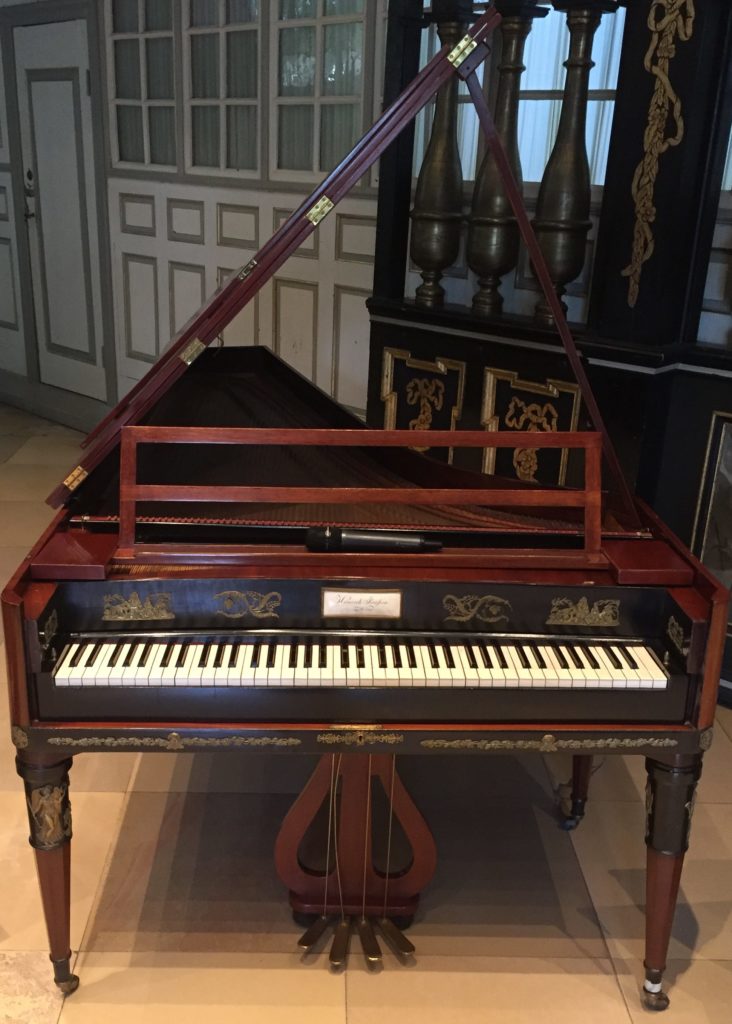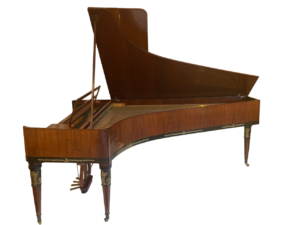Heinrich Janssen c. 1810 – 1815
Description

| Date: | 1810 - 1815 |
| Origin: | Vienna |
| Serialnumber: | --- |
The early Viennese fortepiano represent a significant milestone in the history of keyboard instruments, embodying the transition from harpsichord craftsmanship to early piano development. In the late 18th and early 19th centuries—a period of intense artistic and technical innovation—instrument makers succeeded in combining elements of harpsichord construction with new mechanisms designed to enhance dynamics and expressivity.
The Viennese fortepianos were characterized by a finely tuned hammer mechanism that allowed for variable volume control and immediate feedback between the performer and the instrument. This action was based on a direct connection between the keyboard and the hammers, ensuring a highly responsive touch. These technical innovations laid the foundation for later advancements in tonal development and modern piano construction.
Vienna, as the cultural centre of the time, played a crucial role in the rapid evolution of the fortepiano through its rich musical heritage and the close collaboration between composers, performers, and instrument makers. The expanded expressive possibilities offered by these instruments were reflected in the compositions and performances of figures such as Mozart, Beethoven, and Schubert. The Viennese fortepiano thus contributed not only to the technical evolution of keyboard instruments but also significantly influenced artistic expression and the transition from the Classical to the Romantic period.
The pioneering work surrounding the Viennese fortepiano laid the foundation for the later development of the modern piano. Early experiments with hammer mechanisms and resonance structures led to a continuous refinement of playing mechanics and sound quality, shaping the instrument into what would become the standard for keyboard music in the following centuries.
This charming grand fortepiano made by Heinrich Janssen is a testimony to the elegant and perfect craftsmanship of Viennese piano making in the early 19th century. The case is made of nut and polished with shellac. On the sides and around the keyboard it is decorated with the original fire-gilt bronzes. These bronzes were often lost over the centuries. They were mostly dismantled and sold because of the high value of the artwork or used as fittings for furniture.

Fortepiano made by Heinrich Janssen, Vienna c. 1815 – Eric Feller Collection
The piano stands on 4 original legs with fire-gilded bronzes. The keyboard is made of ivory and ebony, the hammers are covered with deerskin and the piano is double and triple strung. The compass of the keyboard is 6 octaves + fourth (CC – f4). The nameboard bears the inscription on a ceramic label:
“Heinrich Janssen /
in Wien”.
The designation “in Wien” on the nameboard was only allowed to be used by instrument makers who themselves were “ordinary citizens” of the city.
Today there is nothing known about Heinrich Janssen. In some sources Janssen is still reported as a maker of giraffe and lyre pianos.
Till today there are no other known surviving instruments by him. The instrument was restored by Rudolf Haase, Switzerland.
This fortepiano is on permanent display at the Kellinghusen Museum “betont – Ton und Tasten Museum”!
| Length: | 225 cm |
| Width: | 124 cm |
| Height: |
| Circumference: | 6 octaves + fourth (CC - f4) |
| Mechanics: | Viennese action |
| Pedals: | 5 pedals - dampers, due & una corda, bassoon, sordine |
| Signature: | „Heinrich Janssen / in Wien" |

